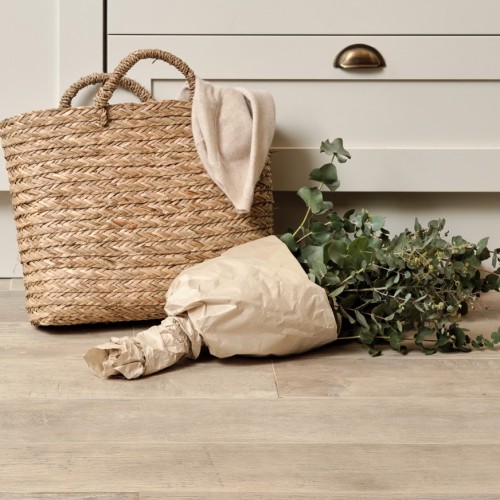
Practical tips
The magical realism of the porcelain floor tile
While we're best known for our unique glazes and for the artistry of our hand painted tile collections we do have another, perhaps less well-known string to our bow. We are specialists in porcelain floor tiles.
The highest quality porcelain tiles offer stone and wood effects that are simply beautiful, and so realistic that they have to be seen to be believed. They are also practical: frost proof, strong, capable of being used with underfloor heating, and completely stain resistant – unlike real timber or stone.
There is a great deal to consider when it comes to choosing porcelain floor tiles, and if like most, you don’t live and breathe the subject, it’s sometimes not until the floor is laid and finished that you know whether you’ve made a good decision.
In our curated offering, you will find only the best. We choose our suppliers with care, importing from the finest porcelain specialists in Italy and Spain. Just those tiles that are virtually indistinguishable from real stone and timber are chosen for our collections.
In today’s article we delve into the world of porcelain tiles, sharing our expertise and decades of hard-earned wisdom on the subject to help you to make the right decision for your space.
L-R French Limestone and Weathered Oak, our latest collections of porcelain floor tiles, are crafted using extraordinary technology to match not just the look but also the feel of the real thing.
What makes a good porcelain tile?
Creating a high quality porcelain tile takes artistry, and it’s the finest details that make an unmistakable difference.
Take our new collection, French Limestone, as an example. Our MD, Jamie discovered these tiles on a research trip to Modena, Italy. They are made using extraordinary new technology which faithfully renders stone in three dimensions. These tiles look and feel just like the sunbaked ancient stone floors of Provence, with its irregularities, tumbled edges and blend of silver and honeyed tones.
To create our latest collection of timber-effect porcelain floor tiles, Weathered Oak, ancient oak floorboards rich with the characteristics of hundreds of years of use are restored by hand by expert craftsmen, before being photographed and masterfully replicated on porcelain using the very latest technology.
But why choose porcelain over the real thing?
Porcelain is strong, durable and easy to maintain. While timber and stone will naturally age and change colour over time, porcelain remains the same as the day it is laid. Drop oil or a glass of red wine on a timber or stone floor and you’re in trouble, but porcelain is completely stain resistant – it doesn’t even require sealing – and any spots are easily wiped away with just a damp cloth.
Where in the home would one use porcelain?
Porcelain is a hardworking yet beautiful option for heavy-traffic areas throughout the home, from hallway to kitchen. It’s a perfect partner for under-floor heating and with its non-slip properties, an excellent choice for the bathroom, and on the floor and walls of a contemporary wet room. Because it is frost-proof you can run it both inside and outside the home, as many of our customers do, from the sitting room out through crittall doors to a terrace or swimming pool surround.
Porcelain tiles can be used inside and outside the home. Pictured above: French Limestone in a four-tile pattern mix.
How are porcelain tiles made?
Creating high quality tiles is a complex process akin to the way we make our colours and glazes, and the manufacturers we work with keep their methods a closely guarded secret.
But in short, porcelain is made from a natural, fine white clay; a mix of feldspar, kaolin and quartz. It is a ceramic just like terracotta, but fired at a vastly higher temperature. The clay is put under enormous pressure by massive industrial presses, resulting in material that is hugely strong.
While it doesn’t sound very elegant, the next step is extremely technical. Photographs of real stone or timber are printed onto the porcelain before firing. Porcelain has almost no porosity and it’s translucent, making it an excellent surface for printing onto. This lack of porosity means that the glaze is not absorbed by the surface, while its translucence creates visual depth. The quality of the camera, the printer, the glazes and finishing are what make a real difference. With cheaper porcelain, the effects can be very poor – designs can be out of focus or pixilated, or you might see some obvious repetition of the pattern. We guarantee you won’t see any of that in our collections.
Next, the surface of the tile is finished. You can choose porcelain tiles with a surface that’s highly polished, smooth, slightly pitted like real stone, or even riven, like a wood or even slate, as if it has laminated over time. A rectified, or straight edge provides a clean finish, or you could choose tumbled edges which look wonderful in period properties and other spaces where you seek to create a traditional feel.
You will find exceptional examples of all of these options in our own collections. Take a look through some of the images below and explore our range in full here.
How does one go about arranging and laying porcelain floor tiles?
The direction in which floor tiles are laid can have a huge impact on how we experience the proportions of a room. If the room is narrow, run the flooring across across the shortest distance to minimise the feeling of a long narrow space. If the room is square, consider using rectangular tiles to create movement.
For traditional character, consider purchasing a tile in a mix of sizes to create a traditional flagstone layout. You’ll find several of our collections, including our new French Limestone collection, are available to purchase this way.
Finally, always place a whole tile at the threshold of a room – it creates a feeling of flow.
If you have any questions about porcelain floor tiles, please don't hesitate to get in touch - we'll be more than happy to assist.
As featured in…
























